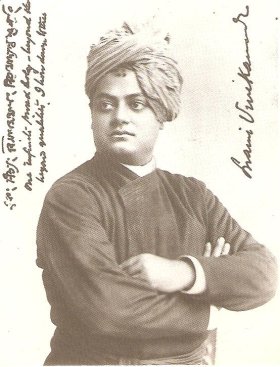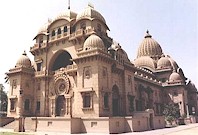Ramakrishna Mission
The Ramakrishna Mission (Bengali: রামকৃষ্ণ মিশন) is an association founded by Sri Ramakrishna's chief disciple and religious leader, Swami Vivekananda on May 1, 1897, who in 1893, when he attended the Parliament of the Worlds Religion at Chicago, was the first Indian guru to visit and to teach in the West. The Mission carries on missionary and philanthropic work through the combined efforts of monastic and householder disciples. The Mission, whose headquarters are near Kolkata, India, is closely affiliated with the Ramakrishna Math (monastery/monastic order). The Ramakrishna Mission emphasizes service to others as karma yoga, a concept found in Hinduism which was a strong motif in Vivekanandra's teaching. It engages in humanitarian activities around the world. Vivekananda saw the same truth underlying all religions and believed strongly in the equality of all. The Mission is dedicated to the service of humanity, regardless of creed, color or nationality. Centers run by the Mission have been prominent in interfaith relations. Philanthropic activities include medical work, education as well as relief and emergency work.
Philosophical Basis
Vivekananda came to the conviction that the same universal truth underlies all religions, although he regarded Vedanta as the best expression of that truth. In a lecture delivered several times in both the United States and Europe, he expressed admiration for Jesus of Nazareth, whom he considered to be a man (but not God) who, like the Buddha had attained the highest spiritual state of being, and who thus ought to be emulated. God, though, is to be found "in Jesus" just as God is to be found "in all the Great Ones that have preceded him, in all that came after him, and all that are yet to come." Our "worship," he continued, "is unbounded and free" and all the great spiritual saints of the world "are manifestations of the same Infinite God."[1] Relating to the criticism made of Hinduism by some Christian missionaries, that it lacked a social ethic being solely concerned with liberation from this world, he argued that according to Hindu teaching, the best person is one who, having achieved liberation, remains to serve others. The only ideal worth living by, he said, is unselfishness. In his closing speech at the Chicago Parliament of the World's Religion, 1893 which he attended, he stated:
- Do I wish that the Christian would become Hindu? God forbid. Do I wish that the Hindu or Buddhist would become Christian? God forbid.
- The Christian is not to become a Hindu or a Buddhist, nor a Hindu or a Buddhist to become a Christian. But each must assimilate the spirit of the others and yet preserve his individuality and grow according to his own law of growth.[2]
In many respects, the Ramakrishna Mission resembles the many Christian missionary organizations that were working in India and elsewhere at the time, and arguably it was to some degree consciously modeled on them. However, Christians were often perceived as offering their medical and educational services as a means to convert people, rather than out of unconditional love. Vivekananda regarded karma yoga as an expression of pure, unconditional love, as the Bhagavad Gita says, "Be intent on action, not on the fruit of action."[3] On the other hand, he can be said to have practiced what he preached in that he assimilated from his contact with Christians their concern for social service and, looking deep into his own tradition, found a philosophical basis for humanitarianism according to "his own law of growth."
Management
The Ramakrishna Mission acquired a legal status when it was registered in 1909 under Act XXI of 1860. Its management is vested in a Governing Body. Though the Mission with its branches is a distinct legal entity it is closely related to the Ramakrishna Math. The Trustees of the Math are simultaneously the members of the Governing Body. The administrative work of the Mission is mostly in the hands of the monks of Math. The Mission has its own separate funds, for which it keeps detailed accounts, audited annually by chartered accountants. The Math and the Mission both have their Headquarters at Belur Math. The Vedanta Society of the City of New York, founded in 1898, is the oldest branch of the Mission in the United States where there are more than a dozen branches altogether. In the developed world, the Mission focuses on education, while in the developing world it engages in both educational and humanitarian activities.
The motto
The Mission is a registered Society laying emphasis on rendering welfare services undertaken with a spiritual outlook. It's mandate is both to serve humanity and to spread the teachings of Ramakrishna. The service activities are rendered looking upon all as veritable manifestation of the Divine. The Motto of the organization is Atmano Mokshartham Jagad-hitaya Cha. Translated from Sanskrit it means For one's own salvation, and for the good of the world.
Math and Mission
Technically, the Ramakrishna Math is a monastic order, and the Ramakrishna Mission is the part of the organization that carries on activities such as disaster relief, operation of schools and charitable hospitals, and other work. However, because the humanitarian activities of the movement are more well-known than the monastic order, and because the monks of the order perform a great deal of the humanitarian work, "Ramakrishna Mission" is popularly used to refer to both institutions. (Note: The use of the name of Sri Ramakrishna or Swami Vivekananda by any institution does not necessarily imply that it is an affiliated branch centre of either Ramakrishna Math or Ramakrishna Mission. Some 90 centers operate in India. Missions are also located in such countries as Bangladesh, Fiji and Sri Lanka, among others.)
Controversies
To a large extent, the Ramakrishna Mission has avoided controversies through its policy of non-involvement in politics. However, in a move that was highly controversial within its own ranks, the Ramakrishna Mission went to the courts in the 1980s in order to have their organization and movement declared as a non-Hindu minority religion. According to the leadership, the mission did this purely as a matter of political necessity: there was a danger that the local government would take control of its charitable schools unless it could invoke the extra protection the Indian constitution accords to minority religions.[4] The Supreme Court of India ruled against the Mission, citing many pages of evidence that it had all the characteristics of a Hindu organization.[5] The wisdom of the attempt by the Mission's leadership to characterize the Mission as non-Hindu was widely questioned within the membership of the organization itself, and the leadership today embraces the Mission's status as both a Hindu organization and as an organization that emphasizes the harmony of all faiths.[6] Most members—and even monks—of the Ramakrishna mission consider themselves Hindus, as did the Mission’s founding father. This resulted in debate about the status of the Mission, whether it was or was not Hindu and indeed whether those considered to be reformist Hindus were still Hindu. Some argue that the type of universalistic philosophy taught by Vivekananda goes beyond traditional Hinduism, others that it is a new interpretation of classical principles[7]
Presidents of the Ramakrishna Mission
The following is the traditionally accepted list of Presidents(spiritual heads) of the monastic order.
- Swami Brahmananda (1901–1922)
- Swami Shivananda (1922–1934)
- Swami Akhandananda (1934–1937)
- Swami Vijnanananda (1937–1938)
- Swami Shuddhananda (1938–1939)
- Swami Virajananda (1939–1952)
- Swami Shankarananda (1952–1959)
- Swami Vishuddhananda (1959–1960)
- Swami Madhavananda (1960–1965)
- Swami Vireshwarananda (1966–1985)
- Swami Gambhirananda (1985–1988)
- Swami Bhuteshananda (1988–1998)
- Swami Ranganathananda (1998–2005)
- Swami Gahanananda (2005–2007)
Prominent monks
Apart from Direct disciples of Shri Ramakrishna, some of the other great monks of the order are
- Swami Adidevananda
- Swami Ashokananda
- Swami Budhananda
- Swami Ghanananda
- Swami Jagadananda
- Swami Nikhilananda
- Swami Nityaswarupananda
- Swami Paramananda
- Swami Prabhavananda
- Swami Premeshananda
- Swami Purushottamananda
- Swami Shambhavananda
- Swami Siddheshwarananda
- Swami Tapasyananda
- Swami Yatishwarananda
- Swami Kirtidananda
- Swami Gokulananda
Notes
- ↑ Vivekananda, "Christ, the Messenger," in Paul J. Griffiths, (ed.) Christianity Through Non-Christian Eyes (Maryknoll, NY: Orbis, 1990, ISBN 0883446626), 204-210.
- ↑ Vivekanada, Closing Speech, September 27, 1989, Concluding Address, The World's Parliament of Religions Retrieved February 8, 2008.
- ↑ Gita, : 47, in B.S. Miller, The Bhagavad-Gita (NY: Bantam, 1986, ISBN 9780231064682), 36.
- ↑ Article 30.(1) gives them greater control over their educational institutions: “All minorities, whether based on religion or language, shall have the right to establish and administer educational institutions of their choice.”
- ↑ Koenraad Elst, “Who is a Hindu?” (New Delhi, Voice of India, 2001, ISBN 8188388254). Who is a Hindu? Retrieved February 8, 2008.
- ↑ ”Monks with a Mission,” Hinduism Today, August 1999, Monks with a Mission Retrieved February 8, 2008.
- ↑ See Koenraad Elst, “BJP Retreat from Ayodhia,” The Weekend Observer, New Delhi, Saturday, December 7, 1996. “BJP Retreat from Ayodhia” Retrieved February 8, 2008.
ReferencesISBN links support NWE through referral fees
- Beckerlegge, Gwilym. The Ramakrishna Mission: The Making of a Modern Hindu Movement. New Delhi: Oxford University Press, 2000. ISBN 9780195651331
- Jackson, Carl T. Vedanta for the West: The Ramakrishna Movement in the United States. Religion in North America. Bloomington: Indiana University Press, 1994. ISBN 9780253330987
- National Seminar on "Philosophy and Science of Value Education in Today's Context." Philosophy and Science of Value Education in the Context of Modern India. Kolkata: Ramakrishna Mission Institute of Culture, 2006.
- Sen, Amiya P. Swami Vivekananda. New Delhi: Oxford University Press, 2000.
External links
All links retrieved December 7, 2022.
Credits
New World Encyclopedia writers and editors rewrote and completed the Wikipedia article in accordance with New World Encyclopedia standards. This article abides by terms of the Creative Commons CC-by-sa 3.0 License (CC-by-sa), which may be used and disseminated with proper attribution. Credit is due under the terms of this license that can reference both the New World Encyclopedia contributors and the selfless volunteer contributors of the Wikimedia Foundation. To cite this article click here for a list of acceptable citing formats.The history of earlier contributions by wikipedians is accessible to researchers here:
The history of this article since it was imported to New World Encyclopedia:
Note: Some restrictions may apply to use of individual images which are separately licensed.

